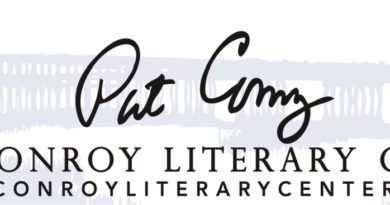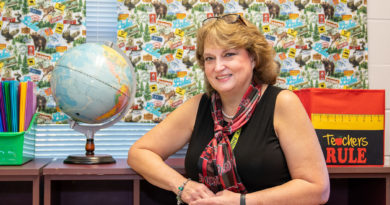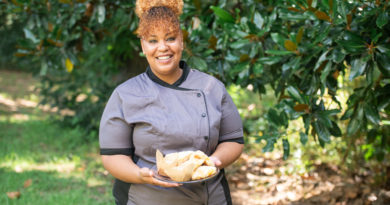Aki Kato: From Japan To Beaufort
Story By: Marsha Stewart | Photography By: Susan DeLoach
Well-known local artist, Aki Kato, has lived in Beaufort since 2003. But the journey to get here has been a long one. Born in Yokohama, Japan in 1957, Aki attended public elementary and junior high schools. He started drawing and painting at a very young age, and by age 7 he already understood art concepts such as perspective and the color wheel.
In 1973, Aki entered military high school and graduated in 1976. Immediately following graduation, he moved alone, with no family, no friends, and no sponsor, to Washington DC to study art and English. While there, he studied English for 10 months at the Catholic University of America.
Aki then moved to Gainesville, Florida and spent the next two years at a nearby community college studying math and science before transferring to the University of Florida. At the University of Florida, Aki studied art, intending to major in oil painting. He did not finish the program, concerned that art was “too unpredictable” to make a living at.
He relocated to Atlanta and struggled to be noticed. As a young artist who had not graduated from art school, it was difficult to have his portfolio taken seriously. Aki took on different jobs to make ends meet. He worked as a waiter, a manager, and a cook. He then returned to Japan and also worked different jobs there. But he was determined to finish an art program and moved back to the United States. This time he landed in Orlando and attended the University of Central Florida where he completed his bachelor of fine arts degree.
After graduation, Aki worked at Universal Studios as a scenic painter. Before long, he moved to Atlanta and had his works displayed at several art galleries including Eclectica, Chicken Lips, and the Defoe Center. He was then hired by Habersham Plantation in Toccoa, Georgia. At the time, Habersham Plantation was the industry’s leading high end, hand painted furniture manufacturer. For the next year and a half, Aki worked at Habersham Plantation before being recruited as head artist by newly formed company, Camden Field, located in Hendersonville, North Carolina.
Camden Field moved to Beaufort in 2002 as a retail custom made hand painted furniture store. The showroom and workshop was located on Robert Smalls Parkway right at Broad River Bridge. In 2004, Aki became an equal partner with owner Lynn Bonge and the pair relocated the showroom to Boundary Street in Beaufort. Camden Field is no longer in business.
When he arrived in Beaufort, Aki immediately felt at home. He explains, “When I was in high school in Japan, I saw a movie about Gullah children on Daufuskie Island. I was mesmerized by the smiling faces of children and vast and beautiful scenery of the Lowcountry. Back then I had no idea where ‘Lowcountry’ was. The movie was Conrack and was an adaption of the Pat Conroy novel The Water is Wide. After I came to Beaufort, I found out that the movie was filmed not far from here and that Pat Conroy lives in the same town.”
In 2006, after Aki and his partner closed Camden Field. He taught ‘Art of Furniture Painting’ at the Technical College of the Lowcountry to supplement his income. In his first class, Aki met a lady who showed him a small planter and asked if he could help her paint it. She said it was for her brother’s birthday. There was an open area in the center of the planter and he suggested that she should write his name and message there. She wrote ‘Happy Birthday Pat.’ Aki asked her what his full name was and it was, in fact, Pat Conroy. Since then, the two have become best friends and, through her, he was able to meet Pat and his siblings Mike, Tim and Jim. Conroy’s siblings, along with Conroy’s wife Cassandra King, are Aki’s biggest supporters and they own many pieces of his artwork.
Conroy’s writings have become quite an inspiration to Aki. He loves painting Lowcountry scenes: the marsh, tidal rivers, live oak trees – all stemming from his earlier love of the novel The Water is Wide. “I like to paint birds, trees, sea creatures, water scenes and working boats,” Aki says of his love of the Lowcountry. He has recently worked with the Pat Conroy Literary Center where he donated a large scale mural.
The Lowcountry Habitat for Humanity is an organization that Aki is actively involved with. “I feel very strongly about their mission and love the idea of ‘re-store.’ They salvage old but good quality furniture and building materials to recycle and repurpose. I have worked in the American furniture industry for 20 years and realized that all the furniture industries in this country are being taken over by foreign countries, especially China. I am very much against buying inexpensive, low quality furniture which is made overseas and has to keep being replaced.”
roduces himself as a “blue collar artist.” He explains, “What I mean by that is, instead of painting things which I like on canvas or paper and sell them in a regular gallery, I enjoy meeting new people and interacting with my clients. I paint any subject on any surface or size, including walls, paper, canvas, salvaged wood, tiles, windows, etc and in any location. It is not as easy as people think. I have worked in different places and learned different styles and techniques. For example, I worked at Universal Studios in Orlando in the early 1990’s as a scenic artist. Scenic artists paint backgrounds of the amusement rides and paint steel structures and fiberglass to make them look like something else. It was here that I learned large scale painting as well as faux finish. Right now, my job as an artist is to understand what my client wants and then help them to visualize and refine their idea, then execute. Therefore the finished product is a collaboration of my client and myself.”
Aki believes that good art is a kind of art which evokes viewers’ emotions and makes them think, whether it is statements for political propaganda or social issues or even something much more simple. He says, “For example, I painted a mural, a picture of a big bald eagle about to catch a squirrel on a large tree. The squirrel is so scared and cannot move and is just gazing at the eagle’s talons. It is a very intense scene. When my client first saw the mural he asked me a question which made me very happy. He asked, ‘Aki, what is going to happen next? Did the squirrel escape or was he eaten?’ That is the kind of reaction I love to get from my clients. I think it is something very similar to a good book. We cannot wait to turn to the next page. Except in my case, the homeowner can decide the outcome.”
Aki Kato is still pursuing his goal to become a better artist. His journey may have begun an ocean away, but it has guided him to Beaufort. He is happy that this has become his home and he is always striving to be a better citizen of Beaufort.
You can visit his website at www.akikato.com or look him up on Facebook at www.facebook.com/akikatostudio




